Forces & Newton's laws

Image: Godfrey Nailer's 1689 portrait of Newton, Wikipedia Commons
Sir Isaac Newton (1622-1727), mathematician and physicist, studied motion and the mathematics required to describe it, developing (concurrently with Gottfried Leibniz) the field of calculus along the way.
In this section, we'll explore Newtons laws of motion, three axioms that Newton proposed to characterize all motion and its changes due to applied forces.
Central to Newton's ideas is the concept of force, so we'll start there.
The four fundamental forces of nature
We know of four fundamental forces in the universe. They are
- Gravity
- Electrostatic force
- Strong nuclear force
- Weak nuclear force
Gravity and the electrostatic force are described in their own sections. The two nuclear forces are involved in holding the positive and neutral charges together in the nuclei of atoms, despite the strong electrostatic repulsion between protons (like charges repel).
Force at a distance vs. contact force
These forces are all non-contact forces; we say that gravity, for example, exerts a "force at a distance." We are also interested in mechanical forces or contact forces, forces where the touching of two objects is necessary for the force to be transmitted. When you push someone on a swing, the push (a contact force) gets him/her going; gravity (force at a distance) keeps him/her swinging; and friction (air resistance, a contact force) slows him/her down.
Force is a vector quantity, so forces add like all vectors do. We call the force resulting from the addition of two or more force vectors the net force. The net force on an object may be zero, even though there may be many forces acting on it.
Contact force → touching
Force at a distance → invisible force
Newton's first law (inertia)
There are a number of ways to state the first law. One of the most often encountered is "Objects in motion tend to remain in motion and objects at rest tend to stay at rest unless acted upon by an outside force."
The first law is called the law of inertia. The idea is pretty clear, but I think we can say it a little more precisely and concisely like this:
Newton's first law: Inertia
Unless acted upon by a net force, an object will maintain its current velocity.
The velocity vector – Review
We ought to review a couple of concepts before we go on. First, recall that velocity is a vector. The only two important things about any vector are its length (the length of a velocity vector is number we call speed) and its direction. In the case of a velocity vector, the direction is the direction of motion.
Remember that the length or magnitude of a velocity vector, which is speed, can be zero (no speed → not moving), so we cover objects at rest. Constant velocity means travel in a straight line, as we learned in another section, acceleration is any change in the velocity vector, which includes its direction.
Net force
Forces are represented graphically and mathematically by vectors. Recall that many forces may come to bear on an object, but unless those forces are "unbalanced" in some way, they will add to zero — no net force. The diagram below shows four equivalent and balanced forces acting on an object.
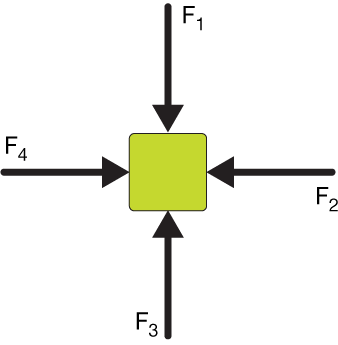
If we add the four force vectors head-to-tail fashion (as we always add vectors), we see that there is no resultant vector (or, more properly, its length is zero), thus we have no net force in this situation. That makes sense. If two friends are each pushing with equal force on each of your shoulders, you might get squished, but you're not going anywhere.
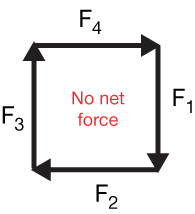
In the next picture, the forces act from the same directions, but they are unbalanced. F2 and F3 are weaker than F1 and F4.
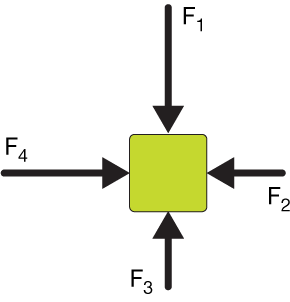
If we add those forces, we have an imbalance, leading to a net force vector (
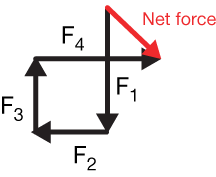
In the first case, the green box would remain stationary; in the second it would move in the direction of the net force vector (down and to the right), and the length of that net force vector represents the magnitude (strength) of the force. Vectors are awesome.
Now we're in a good position to look at Newton's first law again. It takes a force to make anything different happen. An object that's sitting there will sit there forever unless the forces acting on it become unbalanced — unless a net force is generated. And an object that's moving at a constant velocity will not move faster or slower, nor will it change its direction unless acted upon by a net force.
Newton's second law
Newton's second law is perhaps the most important physical law in mechanics. It says that the acceleration of an object is proportional to the net force applied to it and inversely proportional to the mass (reflecting inertia).
Newton's second law
Force = mass × acceleration
$$F = ma$$
The second law says that:
- A mass can't be accelerating if there is no net force acting on it.
- If a mass is accelerating, there must be a net force working on it.
- Acceleration is inversely proportional to mass; for a given force, the acceleration decreases as the mass increases.
- Acceleration is directly proportional to net force; the greater the force, the greater the acceleration.
Newton's third law
Newton's third law will also likely be familiar. You've probably heard "for every action there is an equal and opposite reaction." Again, here's a more precise way of saying it:
Newton's third law
Forces come in pairs. If an object $A$ exerts a force ($F_A$) on object $B$, then object $B$ exerts an equal but opposite force ($F_B$) on object $A$: $F_A = -F_B$.
Newton's third law will lead us directly to the law of conservation of momentum later, and it will help us to tie the forces of the universe together to give us a coherent picture of why familiar objects act and interact in the ways that they do.
Example 1
Object at rest: Normal force
Consider the apple on the table. The object is not moving, so the magnitude (length) of its velocity vector is zero. Not moving means not accelerating, so according to the second law, $F = ma = m·0 = 0,$ the net force must be zero.
But we know that the gravitational force $(F_g)$ is pulling the apple downward with force $F = -mg$ (I have chosen downward to the the negative direction, which is typical. As long as we're consistent, it really doesn't matter).
Because the net force must be zero, there must be another force that exactly opposes the gravitational force. We call it the normal force ($F_N$), and it is a result of the electrostatic repulsion between the electrons that make up the atoms of the apple and the table.
$$F_{net} = F_g + F_N = 0 \: \text{ because } \: F_g = -F_N$$
The normal force is the reason gravity doesn't pull the apple right through the table. After all atoms are mostly empty space.
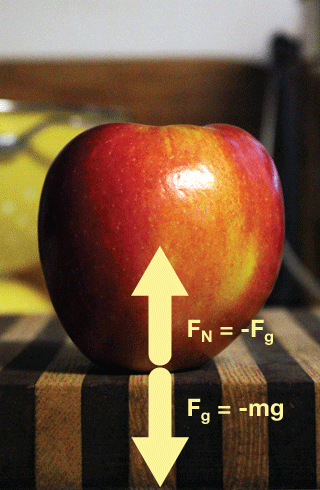
J. Cruzan, 2012
Example 2
Object with horizontal acceleration
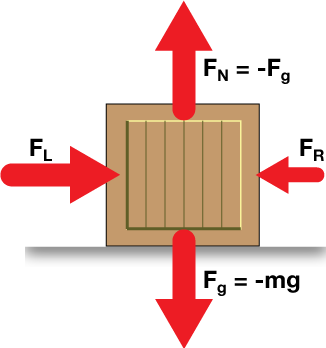
← Now consider an object sliding across a surface like this one. The box has mass, so there is a downward force, $F_g$, on it. It is sliding straight across a horizontal surface, so the normal force and $F_g$ must be in balance: $F_g=-F_N$ .
The object is accelerating to the right, so the left-right forces, $F_L$ & $F_R$ must be unbalanced, with $F_L \gt F_R$.
Newton's second law tells us that $F = ma$, and we remember that the force here is always the net force. So the acceleration of the crate is just $F_{net} m$, where $F_{net}$ is the vector sum of the left and right force vectors, $F_{net} = F_L + F_R$, where the signs of $F_L$ and $F_R$ are opposite because they work in opposite directions. In the figure, I've just subtracted the two. Either way works as long as you keep track of the directions of forces).
There is no acceleration in the up-down direction because those forces are balanced.
By the way, in this situation, where the left force might be a pushing force, the rightward force might be friction. The friction force always opposes the motion. A forthcoming friction section will help make this clear.
Example 2a
Acceleration of a moving box
Calculate the acceleration of a 20 Kg box moving across the floor if a 10 N force is exerted from the left, and that force is opposed by a 1 N friction force from the right (friction is a force that always opposes the motion).

Vertical forces
The force of gravity on the box is
$$ \begin{align} F_g &= mg \\[5pt] &= (20 \, Kg)\left(-9.81 \, \frac{m}{s^2}\right) \\[5pt] &= -196.2 \, N \end{align}$$
where we have set downward as the negative direction.
The upward force exerted by the floor on the box (the normal force) must exactly balance the force of gravity, so it will be $F_N = 196.2 \, N$
Horizontal forces
The net horizontal force is just the vector sum of the forces acting horizontally. These include a +10N force from the left (I'm arbitrarily assigning forces pointing to the right to be positive here, but as long as you're consistent, it really doesn't matter which direction you choose to be positive). That makes the 1 N friction force a negative force, so our total horizontal force is
$$F_H = 10 \, N - 1 \, N = 9 N.$$
Now it's easy to calculate the acceleration from Newton's 2nd law:
$$ \begin{align} F_{net} &= ma \; \color{#E90F89}{\longrightarrow} a = \frac{F_{net}}{m} \\[5pt] a &= \frac{9 \, N}{20 \, Kg} \\[5pt] a &= 0.45 \frac{m}{s^2} \end{align}$$
Now you might wonder why we even calculated the up/down net force. After all, the net force in that direction is zero (the box isn't moving in the up/down direction), and clearly it doesn't contribute to the left/right acceleration. Well, that's not entirely true, as we will see later when we discuss friction. Here we were given the friction force, $F_f = 1 \, N,$ but in general, the friction force will depend on the normal force. You might imagine that if we piled more weight on top of our box, it would increase the friction between the box and the floor.
Example 3
Object in motion at constant velocity
Now this is a tricky one, but if you just go back to Newton's laws, you'll get it.
Consider an object in motion at constant velocity, like the firefighter sliding down the pole →.
If the velocity vector of the firefighter doesn't change, then because $a = F_{net}m$, (and the firefighter certainly has nonzero mass), $F_{net}$ must be zero. That means that any downward force must be perfectly balanced by some upward force.
In this case, that upward force is the friction force. The firefighter can increase or decrease his friction with the pole by tightening or loosening his hold. A friction force less than the gravitational force will cause downward acceleration.
- A friction force exactly equal to the downward gravitational force leads to constant-velocity motion.
- A friction force greater than the gravitational force will cause the firefighter to slow and eventually stop because there is a net upward force.
- A friction force less than the gravitational force will cause the firefighter to accelerate down the pole because there is a net downward force.
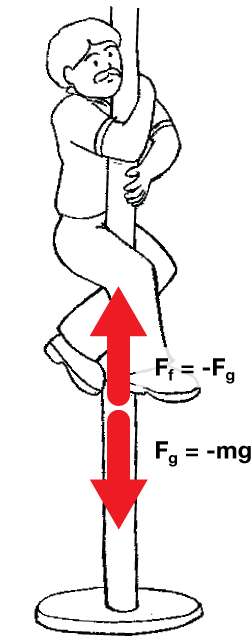
Image: http://lincoln.ne.gov/city/fire
Example 4
The ramp — a "free body diagram"
Consider a ball rolling down a ramp like the one below. We almost always change our coordinate system from one in which the $x$-axis is parallel to level ground to one in which it parallels the ramp. It's much more convenient that way, and nature doesn't really care about our coordinate system anyway. We can then resolve the gravitational force vector, $F_g$ into components parallel to our new axes:
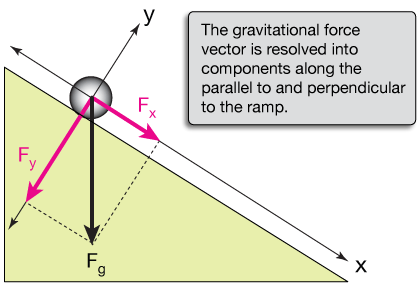
We can do better at listing the forces in such a diagram. The force pointing into the ramp, $F_y$ is countered by the normal force, the force of the ramp pushing back on the ball. Likewise, the force pushing the ball down the ramp is countered by some frictional force, $F_f$.
The whole free-body diagram, showing all forces in play, looks like this:
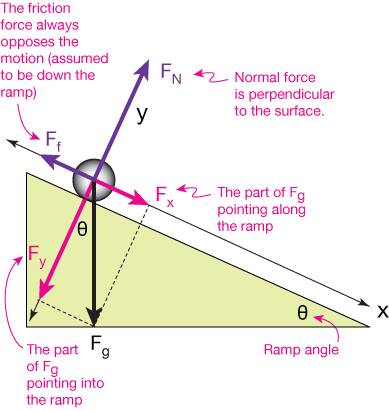
You'll have to think about parallel lines and congruent angles to see that the angle between $F_y$ and $F_g$ is just the ramp angle, $\theta$.
The trigonometry that gives us our component vectors relative to $F_g$ is
$$ \begin{align} \text{sin}(\theta) &= \frac{F_x}{F_g} \\[5pt] \text{so } \: \: F_x &= F_g \, \text{sin}(\theta) \end{align}$$
and
$$ \begin{align} \text{cos}(\theta) &= \frac{F_y}{F_g} \\[5pt] \text{so } \: \: F_y &= F_g \, \text{cos}(\theta) \end{align}$$
The two ramps below illustrate why the acceleration of a rolling ball is greater down a steeper ramp: The component of the gravitational force, the only force present that makes the ball roll, is greater down the ramp when the ramp is steeper.
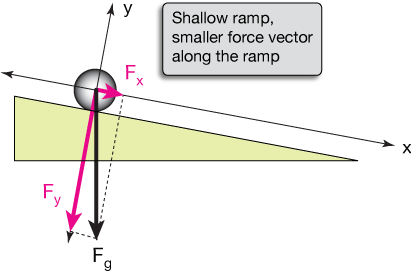
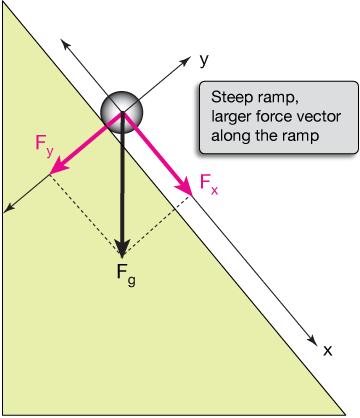
Video examples
Here are some examples of how to use Newton's laws in a variety of situations.
Example 1
A wagon is pulled by applying a force at an angle to the direction of motion. Calculate the resulting acceleration of the wagon.
Minutes of your life: 2:44
Example 2
This example is similar to the previous one, except that we put a load in the wagon and friction is a factor.
Minutes of your life: 4:47
Example 3
I found an error in this example. I'll have it reposted soon.
Minutes of your life: 0:00
Example 4
A crate is pushed up a ramp with a force parallel to the ground. Friction is a factor. We calculate the net force up the ramp and then the resulting acceleration of the crate.
Minutes of your life: 5:38
Example 5
This is a convoluted example that requires us to use many notions of mechanics, including Newton's laws and momentum. Very worthwhile to understand.
Minutes of your life: 2:44
Example 6
Working on it ... stay tuned.
Minutes of your life: 0:00
Axiom
An axiom is a statement that is regarded as being true or established, or self-evidently true. Axioms cannot be proven.
A fundamental axiom is the transcendental property: Things that are equal to the same thing are equal to each other, or if a = b and c = b, then a = c.
magnitude
Magnitude means size. The magnitude of a vector is its length. We can also refer to orders of magnitude of numbers. In that case the magnitude is the number of zeros after or before the 1's digit.

![]()
xaktly.com by Dr. Jeff Cruzan is licensed under a Creative Commons Attribution-NonCommercial-ShareAlike 3.0 Unported License. © 2016-2025, Jeff Cruzan. All text and images on this website not specifically attributed to another source were created by me and I reserve all rights as to their use. Any opinions expressed on this website are entirely mine, and do not necessarily reflect the views of any of my employers. Please feel free to send any questions or comments to jeff.cruzan@verizon.net.